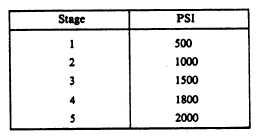contaminated or the cylinder has remained empty
for more than 2 hours, purging is required. If an
emergency oxygen cylinder does not warrant the
purging process, proceed to step 10 for the
charging sequence. If it is necessary to release
pressure in the oxygen bottle before
purging/filling, pull the emergency oxygen
lanyard. This releases the pressure through the
pressure reducer. DO NOT release pressure
through the filler valve or adapter. Releasing high-
-pressure oxygen through the restriction of the
filler valve causes heat, and a fire or an explosion
may result.
3. Deplete the emergency oxygen cylinder,
if necessary.
4. Connect a nitrogen source to the filling
adapter and close the pressure reducer.
5. Slowly pressurize to 100 psi with a
nitrogen temperature of 110° to 130°C (230° to
266°F) using an electric heater.
6. Turn off the nitrogen source and deplete
the oxygen cylinder.
7. Repeat steps 5 and 6, twice.
8. With the pressure reducer open, turn on
the nitrogen source and purge for 10 minutes at
a temperature of 110° to 130°C (230° to 266°F).
9. Turn off the nitrogen source and
disconnect it.
10. Connect the oxygen source to the filling
adapter with a suitable pressure regulator and
shutoff valve. Reset the pressure reducer.
11. Slowly pressurize to 100 psi.
12. Deplete the cylinder to 50 psi.
13. Ensure that minimum slack exists in the
actuating cables of the reducer/manifold, and that
they are tight enough to ensure full engagement
of the toggle arm.
14. Charge the emergency oxygen system in
stages in accordance with table 7-4 until the
pressure gauge indicates correct pressure for
existing ambient temperature, as indicated in table
7-3. Carefully observe the scheduled filling stages,
since rapid application of oxygen pressure creates
Table 7-4.—Charging Stages
heat, which may result in fire or explosion. Allow
no less than 3 minutes for each filling stage and
2-minute intervals for cooling between stages. If
the kit is to be stored or shipped, fill it to 200 psi
(when needle on gauge bisects E of REFILL).
15. Loosen the filling adapter until all
pressure is bled from the high-pressure line.
Remove filling adapter. Visually ensure that the
filler valve does not turn as the filling adapter is
removed. Serious injury could result.
16. Apply leak test compound around the
filler valve, gauge, and reducer. Check for leaks;
then wipe connections clean, using a lint-free
cloth.
17. Replace the oxygen filler valve cap on the
filler valve.
18. If the personnel parachute and survival
kit assembly were removed from the aircraft in
step 1, reinstall them at this time.
As you know, there are a variety of seat kits
available. Although the basic principles of
operation are similar, they differ in accordance
with the aircraft in which they are issued, their
contents, and the type of ejection seat in the
aircraft. Additional information concerning
updating, modification, inspection, maintenance,
etc., of seat survival kits can be obtained from
NAVAIR 13-1-6.3. Aviation Crew Systems Seat
Survival Kits.
7-9

